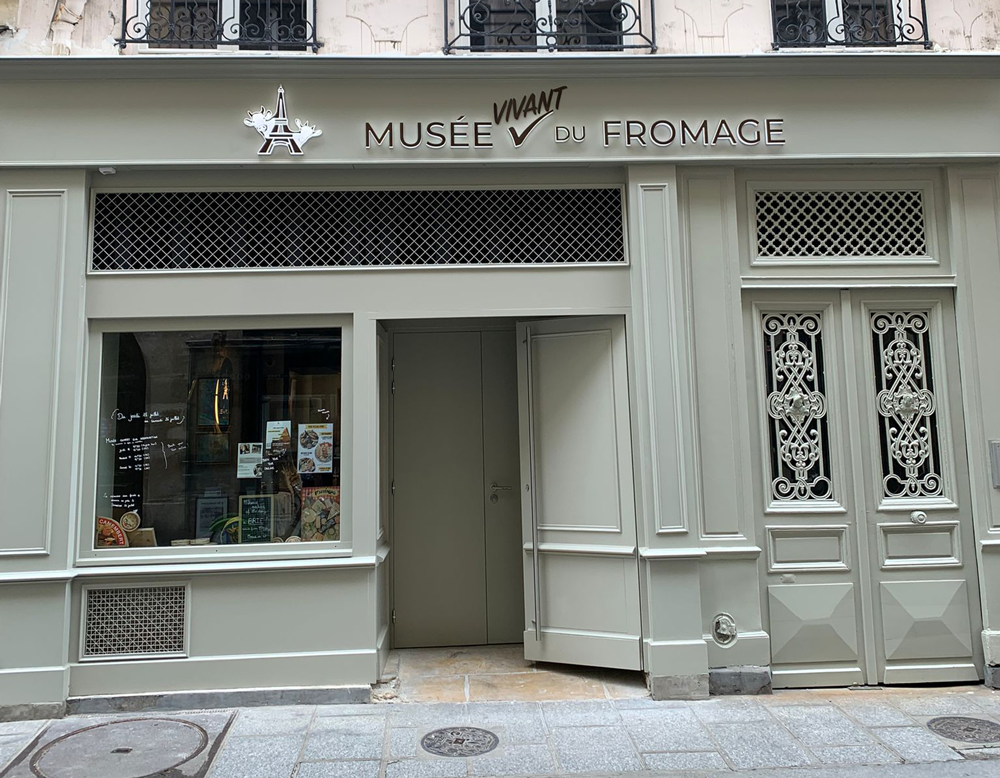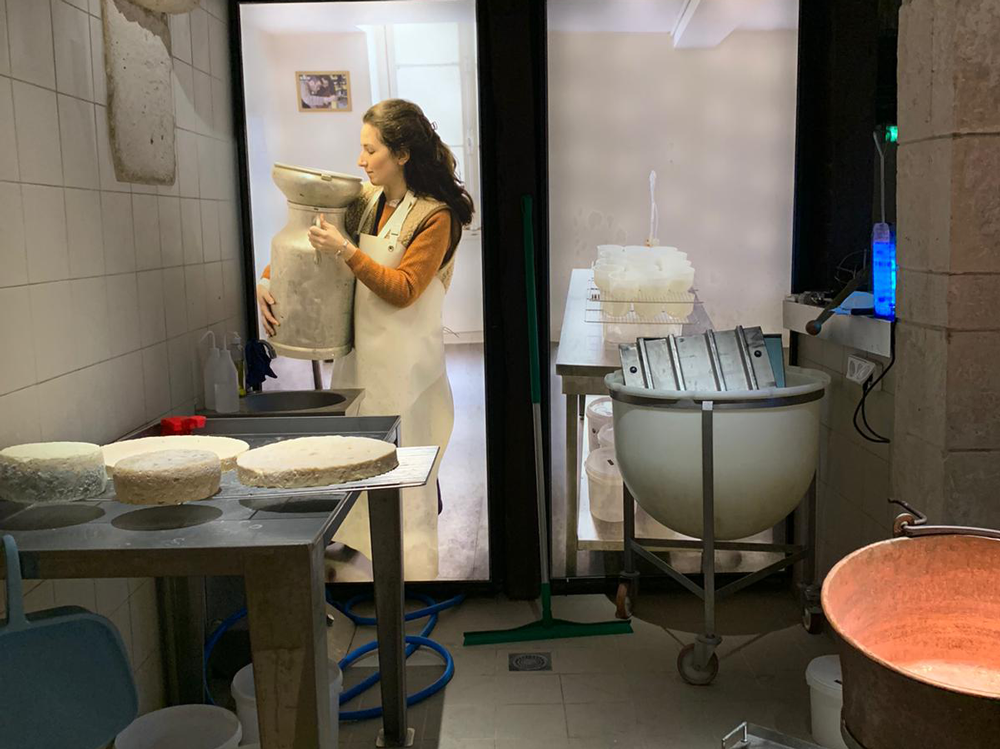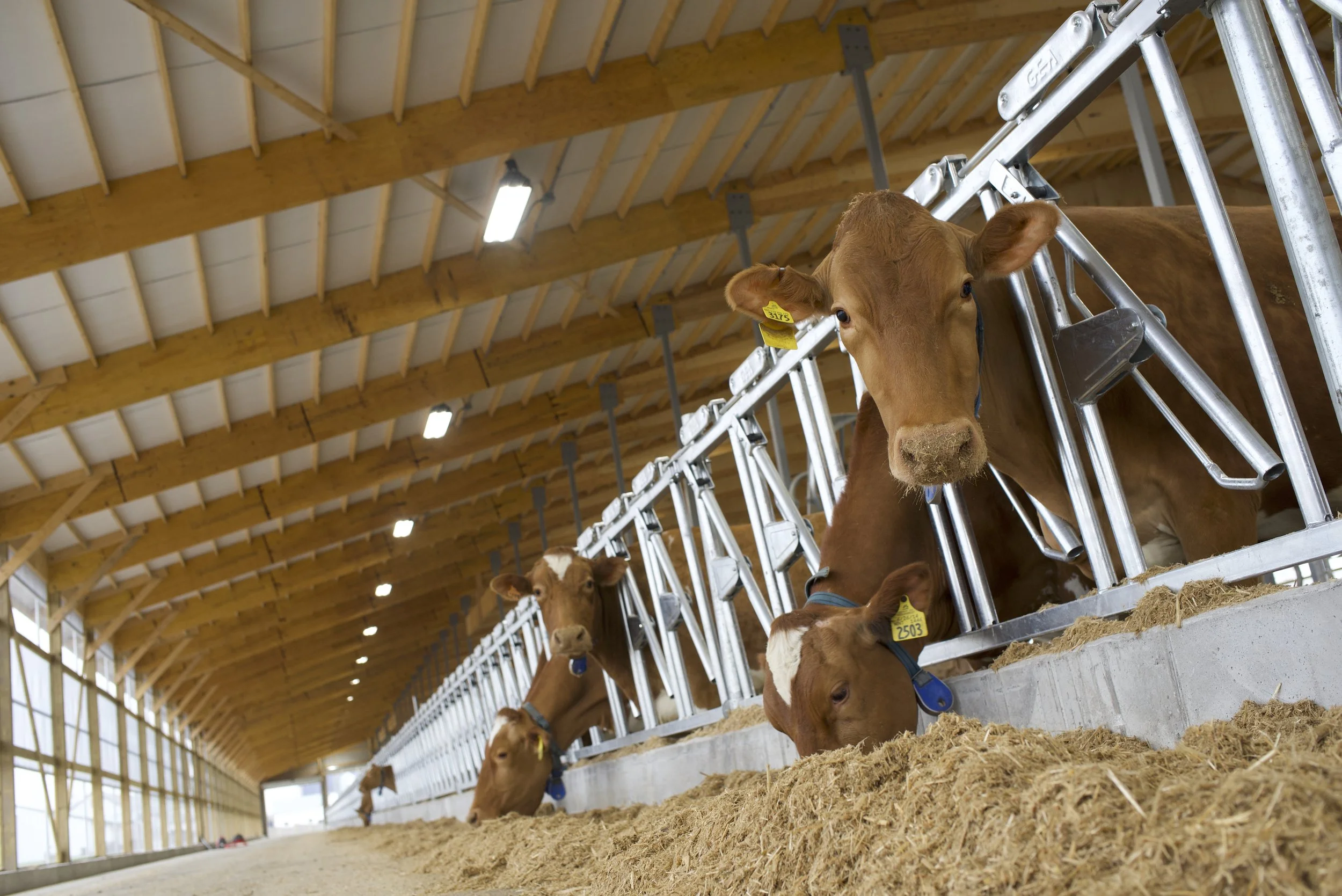France’s first cheese museum puts producers in center stage
At Paris’s Musee du fromage, locals and foreigners can learn about the unique history and varieties of French cheese.
Steps from the Notre Dame cathedral, on land once lauded for its graze-friendly grasses, le Musée du fromage stands as a living lighthouse for the future, adorned in vision and bejeweled by layers of the past.
As France’s first and only museum dedicated to cheese and cheesemaking, Musée du fromage — newborn to the city of love — has its work cut out for it. But if there’s one thing Parisians (nay, everyone) loves, it’s tastefully curated curd, and that’s exactly what Musée du fromage celebrates. Its mission is not only to educate the public about French cheese and its history, but, too, to champion the livelihood of dairy producers across the country.
Museum owner and cheese and wine expert Pierre Brisson sees this attraction’s inception as an opportunity rich with purpose.
“I want to bring the love and understanding of cheese to the public,” Brisson said. “I want people to leave [the museum] thinking about France’s incredible regions and the producers and farmers who live there.”
France is already well known for its cuisine — de la ratatouille et du vin de Bordeaux, anyone? — but little is known about the diversity and particulars of its cheese.
The country contains quite a unique confluence of climates: oceanic, Mediterranean, mountain, and continental. Each provides singular environmental conditions under which food may be prepared, so, by nature of existing under these distinct conditions, French cheese possesses a wide variety of tastes and textures simply by being the product of vastly differing regions.
This fact is highlighted in the museum’s exhibition room, which includes a wall-borne history of how French cheese, in all its variants, came to be. Also included in this space is an interactive screen upon which one may take a quiz determining “what kind of cheese they are.”
Following the exhibition is a small but functional creamery where visitors can view cheesemakers at work in real time, every day of the week. Then, guests are led by their guide to a cheese tasting room, where a variety of French cheese awaits topping a culinary favorites list.
The tour also includes information on over 300 French dairy producers, including farm locations, so guests may further their learning. Ideally, for Brisson, the museum and its encouragement of continued dairy education will inspire a whole new generation of cheesemakers.
“I want people to leave the experience thinking, ‘Now I want to make cheese,’” he said. “There isn’t a lot of advertisement about the profession.”
But why? There are multitudinous national education efforts about French wine. Wineries themselves invite guests to visit their grounds and taste test on-site.
For dairy producers, Brisson said. It’s different. Farmers aren’t likely to invite tourists directly to their farm because animal care and land cultivation has to be carefully monitored and protected. One’s operation is under the inherent risk of whoever is there at any given time, so it carries that producers don’t play host.
This is why a museum like the one Brisson has built from scratch is so important: It provides a window where there isn’t one. It acts as binoculars into the world of dairy farming and cheesemakers, while encouraging further support and appreciation for the people and animals who bring milk and cheese to the table.
If you find yourself in Paris, pay the place a visit. If it’s anything like my globe-trotting sister described it to be on her stop along the Olympic spectator way, you won’t be disappointed.
In the meantime, check out Hoard’s Dairyman Farm Creamery’s selection. It may not be French, but it stands the test of excellence.
Summer has the monopoly on dairy appreciation
Frozen yogurt
For those of us who live in a region defined by its seasons, there is no better time of the year to indulge in all things dairy than summer.
Chilled smoothies, iced coffees, frosted milkshakes, ice cream cones, ice cream sundaes, ice cream sandwiches, ice cream cakes…beastly hot days call for beastly good snacks.
And if the heat weren’t incentive enough to consume double the food group for three months out of the year, June is National Dairy Month, June 4 is National Cheese Day, July is National Ice Cream Month, and August is National Goat Cheese Month.
I’m convinced: I have to stop for frozen yogurt on the way home. The national calendar catalog says so!
But with August’s end just around the corner and the beckoning of autumn a song in spreading breezes, is it too late to pay homage to the summer-dominating industry that is dairy? We think not.
Dairy products are just about everywhere, and they’re ready at hand to enhance a late summer gathering.
Hoard’s Dairyman Farm Creamery’s selection of pure Guernsey milk cheeses pay tribute to, as W.D. Hoard put it, the foster mother of the human race. If you’re looking for all-around quality cheese board staples, look no further.
If mixed milk cheeses are your thing, search for creameries in your area whose curd comes from cow, sheep, and goat milks. Some creameries, such as LaClare Creamery in Malone, Wis., specialize in goat milk products, making them a perfect destination for the August’s chèvre theme.
Looking to improve your morning cold brew with additional health benefits? Top the glass off with a splash of value-added milk. Not only will it mean less digestive upset for lactose-intolerant folks, but it may get you closer to your protein goals.
Eager for a bowl of traditional, slow-churned ice cream? Take a last-minute summer vacay to Cincinnati, Ohio, home of Graeter’s Ice Cream, to experience the dessert at its finest. Or, you can order your favorite flavor from their online store.
Dairy comes in all shapes and sizes, and it is nutritionally sound every day of the year. But while the food industry spotlight is on the cow and her cousins, let us celebrate what goes into making that cheese board possible. Let us nod to the farmers and makers around the world who make monstrously hot months like these more bearable.
Who knows? Maybe one day there will be a National Butter and Sour Cream month. With dairy, the possibilities are endless.
Quiz time! Test your Guernsey cow knowledge, temperament edition
Guernsey cows have a generally _____ temperament.
a. Volatile
b. Aggressive
c. Mild
d. Irritable
Scroll past the photo to get the answer!
Guernsey cows at the Hoard's Dairyman farm
If you guessed C. Mild, you’re right! Guernsey cows generally have a mild temperament.
Cheddar nuggets galore
County fairs spotlight dairy farmers and Wisconsin cheese.
Cheddar nuggets with ranch.
Summer is for county fairs. Draft horse shows, carnival rides, magic shows, fresh squeezed lemonade, log rolling — the enormous week-long gatherings represent what it is to let loose in the United States: terrible fun, fried food, and exorbitantly priced, winner-never games.
If you don’t go to the fair, you’re likely missing out on a quintessential American right of passage. For Midwest folks, you’re also forfeiting a chance to experience cheese curds at their finest.
Hot, stringy, melt-in-your-mouth…fried county fair Wisconsin cheese curds are about as iconic as they come. Just ask Belvidere, Illinois’, 2024 Boone County Fair attendees. Some of the most populous lines across the grounds were those for vendors advertising “Wisconsin cheese.”
Dairy barn at the Boone County Fair
A (purely educational) taste test of my own halfway through a day-long fair excursion confirmed that the acclaimed “cheddar nuggets” were, in fact, an experiment in perfection. If their chewy plumpness and savory center weren’t enough, the crisp edge of their exterior sealed the tastebud deal. Among my party, they were the night’s clear winner.
But dairy at the fair is not limited to decadence. A quick jaunt down the dirt road from where our senses took root lay the designated dairy barn, where attendees could walk past stall after stall of beautifully groomed dairy cows.
“They get bathed and blown out before their showing,” said 4-H alumni Becky Schroll. “The best cow gets an award.”
“Best” can mean a set of criteria ranging from rump and hooves to legs and udders. A judge examines each entry and determines which meets these requirements with the most precision. The shows aren’t just for awards, either.
“Local companies support 4-H members by purchasing shown livestock at an auction,” Schroll said.
In the barn, each and every farmer’s face told the story of dedicated agricultural labor. Exhausted family members napped beside their stalls in touching solidarity with the animals they care for.
It’s easy, I realized, to forget about the people who make possible our daily nutritional servings. Basket of cheese curds in hand, stunning heifers on either side of the path ahead, I paused to take it all in. I thought about how lucky we all were to bear witness to the great service that is dairy farming.
Hoard’s Dairyman Farm Creamery cheeses may not come battered and fried, but they can be made to be so. Peruse our selection and decide on your own unique path into the world of quality dairy products.
Quiz time! Time to test your Guernsey cow knowledge.
Q: Guernseys weigh about ______ pounds at maturity.
A. 800 - 1,000
B. 1,200 - 1,300
C. 1,800 - 2,000
D. 500 - 700
Scroll past the image for the answer!
If you guessed B. 1,200 to 1,300 pounds, you would be right! Guernsey cows are large animals, but they’re not the largest dairy cow breed.
Our farm gets a shout-out
On July 16, Fox News profiled the Hoard’s Dairyman Farm in a prolific ode to farmers everywhere.
In a recent Fox News segment, reporter Steve Doocy visited the Hoard’s Dairyman Farm in Fort Atkinson, Wis., to learn more about America’s Dairyland and show appreciation for modern-day farming.
During the tour, he interviewed Hoard’s Dairyman editor Abby Bauer, W.D. Hoard and Sons Co. president and owner Brian Knox, and Hoard’s Dairyman Farm manager Jason Yurs.
The farm was established in 1899 by W.D. Hoard, who had started the Jefferson County Union and then Hoard’s Dairyman magazine years earlier.
“Hoard was the father of the entire American dairy industry,” Knox said. And that industry is shrinking — fast.
“Today, there are just around 26,000 dairy farms across the U.S.,” said Bauer. “Thirty years ago, there were about 125,000.”
Most of those 26,000 farms have been in the same family for generations, Bauer continued. But as costs of necessities from machinery to fertilizer rise with no sign of coming down, staying afloat is increasingly difficult.
“A tractor that cost $400 when I was growing up now costs $170,000,” Doocy said.
This was Hoard’s mission then, and it is Hoard’s Dairyman’s mission still: to be a voice for dairy farmers, to champion them in their profession, and to make possible the continued progression of the industry.
“We’re trying to help the modern-day farmer learn about new technology that’s available, new research that’s being done, and anything that can help them be more profitable,” Bauer said.
Doocy paid a visit to the robotic milking parlor and the freestall barn, among other notable farm localities.
While standing in front of a row of stunning Guernseys, Doocy said, “It’s so easy to grab a gallon of milk out of the cold case at the grocery store, but it’s a long journey to get it there.”
Ancestry — Herds’ Version
Cows are not indigenous to the Western Hemisphere. So where did they come from? Studies show that cattle were brought to the New World as early as the 15th century.
Cows were as early a settler to our land as the pilgrims. According to the essay “The Introduction of Cattle Into Colonial North America” by G.A. Bowling, Christopher Columbus’ second voyage in 1493 included a shipment of cattle, which would be the first domestic livestock to inhabit the “New World.”
From there, a combination of these cattle — plus French, Dutch, and African breeds, introduced to regions spanning from the Caribbean to modern-day California — merged to become the cattle raised across North and South America today.
The animals were primarily used for work, rather than meat and dairy production, although milk did become a staple for both adults and children around the early 17th century, right around the time mass cattle imports slowed.
Three centuries later, Americans took on a new cow-venture: providing the occasion for the arrival of Antarctica’s first domesticated bovine guest. Richard E. Byrd led an expedition to the continent with three sponsored cows (and one unborn calf).
With the increasingly specific research that is being done on herd histories, it’s entirely possible we have yet only scratched the surface of cattle’s origin stories. However, given the knowledge we do have, it’s safe to say the dairy you consume today can be traced back to beasts of old — beasts of a time when milk meant staving off starvation and drawn plows meant soil for the season’s harvest. When hand and hoof meant the beginning of a now flourishing industry.
Learn more about your herd’s ancestry on the Journal of Dairy Science’s website, and shop our selection of historic Hoard’s Dairyman Farm Creamery cheeses at www.hoardscreamery.com.
Will bike for cheese!
The largest road cycling series in the U.S. featured Hoard’s Dairyman Farm Creamery cheese as its winning prize.
Our Creamery Director, Ricardo, presents the winners with their prize: Hoard’s Dairyman Farm Creamery cheese.
From June 13 to June 23, Wisconsin’s 15th annual Kwik Trip Tour of America’s Dairyland led cyclists across the southeastern part of the state on a quest for victory — an honor that this year included wheels of Hoard’s Dairyman Farm Creamery Belaire cheese.
Bill Koch — one of the event’s founders — said the tour is a way to bring communities together and celebrate the state’s deep dairy identity.
Professionals, amateurs, and kid cyclists alike sign up to join a variety of races put on every day for eleven days.
Courses range from a half-mile to a full mile. Competitors race the course for up to 75 minutes and receive points based on their finishing order in each race they compete in. Overall winners are determined based on points earned by racing various series ranging from five to eleven days.
“Our average rider races five to six days,” Koch said. “So, it’s a whole smattering of combinations of race days for the various athletes that do it.”
A sporting event as well as a community block party that celebrates America’s Dairyland, the tour attracts competitors from far and wide. This year, the pool of athletes represented 41 states and 14 countries.
Ricardo with Alice in Dairyland
Our own Ricardo Gutierrez attended the event as a Hoard’s Dairyman Farm Creamery representative. He handed winners the symbolic Hoard’s Dairyman Farm Creamery wheel on the podium. It was empty. They get the cheese later, because no one wants to hold both a race trophy and a five-pound cheese wheel above their head minutes after racing! He also worked with Koch and other officials to promote Wisconsin dairy by including wedges of Hoard’s’ Cheddar in event-day swag handouts.
Check out the official Tour of America’s Dairyland website to learn more, and visit www.hoardscreamery.com to order your own variety of Hoard’s Dairyman Farm Creamery cheese.
Dairy’s new era
A cutting-edge research facility broke ground this summer in Wisconsin.
NPR’s Wisconsin Public Radio recently published an article about the construction of a new dairying research facility in Prairie du sac, Wisc.
The facility, funded by a partnership between The U.S. Department of Agriculture (USDA) and University of Wisconsin-Madison’s College of Agriculture and Life Sciences (CALS), is intended to “tackle key issues affecting dairy farms across the country.”
Some of what the researchers will be looking into includes robotic milking equipment, manure-borne pathogen prevention, improving soil health, and other holistic studies of modern dairy farming practices.
There are two kinds of robotic milking systems: free flow and guided flow. In a free flow system, cows can approach the robots at any time to see if they are eligible to be milked. In a guided flow system, a series of gates direct cows to the robots or the feedbunk. Researchers will look into what the benefits are of both, as well as how to make milking and cow care more efficient in this era of labor shortages.
Experts involved with the construction of the new research facility hope it will help bring about “resiliency in the face of climate change” for farmers across the nation.
At the Hoard’s Dairyman Farm, we already implement many of these technologies. In fact, the farm was showcased in the NPR report as a dairy already on the cutting edge of the technological revolution in agriculture. Our top-notch milking systems bring pure Guernsey milk from cow to consumer – and make possible the crafting of our award-winning cheese.
The dairy research facility is scheduled to be completed in 2027.
Quiz time! Test your Guernsey cow knowledge.
The two breeds Guernseys are thought to have come from are _______ (nationality).
A) French
B) English
C) Irish
D) Portuguese
(Scroll past the photo to see the answer!)
Guernsey cow calf
Answer: If you guessed A) French, you’re right! The two breeds of Guernseys are thought to have originated in France.

















